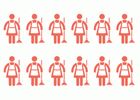1 - 20 of 22 Results
Pagination
Date:
In times of crisis, violence against women and girls is likely to increase as security, health, and money worries heighten tensions and strains are accentuated by cramped and confined living conditions.
Date:
Women’s full and equal participation in all facets of society is a fundamental human right. Yet, around the world, from politics to entertainment to the workplace, women and girls are largely underrepresented. Take a closer look at this gender-imbalanced picture over time.
Date:
Women are entitled to the full and equal enjoyment of all of their human rights and to be free from all forms of discrimination.
Date:
Periods. Menstruation. Monthlies. Call it what you want. But there’s a whole lot to talk about.
Date:
Women’s full and equal participation at all levels of society is a fundamental human right. During times of conflict, women’s participation in resolving conflict and negotiating peace is especially important to ensure that women’s rights are protected, experiences are recognized, and that peace lasts.
Date:
“Turning promises into action” is UN Women’s global report on gender equality in the 2030 Agenda for Sustainable Development. It makes an urgent call to step up efforts to end discrimination against women and girls everywhere. This infographic puts a spotlight on where the global community stands on gender equality under each of the 17 SDGs, and ends with a call to action on ways to make women and girls count going forward.
Date:
Today, 50 per cent of refugees uprooted from their homes from conflict, persecution or natural disasters are women and girls. This translates to more than 11 million refugee women and girls. During times of crisis, their specific needs and voices are often neglected. Here are just some of the objects that give women and girls agency and secure their health, dignity and rights.
Date:
Meet some of the women in tech inspiring the next generation.
Date:
Rural women ensure food security for their communities, build climate resilience and strengthen economies. Yet, gender inequalities, such as discriminatory laws and social norms, combined with a fast-changing economic, technological and environmental landscape restrict their full potential, leaving them far behind men and their urban counterparts.
Date:
Violence against women and girls manifests itself in physical, sexual and psychological forms. Learn how.
Date:
A sudden or gradual change in appearance or behaviour can be an indicator that abuse or neglect has occurred (or may still be happening). Learn more about the signs of relationship abuse.
Spotlight on Sustainable Development Goal 5: Achieve gender equality and empower all women and girls
Date:
Gender equality and women’s empowerment is integral to achieving the Sustainable Development Goals (SDGs). This thematic spotlight is part of a series showcasing where women and girls stand against select SDG targets and was produced in support of the High-level Political Forum on Sustainable Development at UN Headquarters in New York from 10–19 July, 2017.
Date:
Indian Ocean Rim countries have set change in motion, investing in laws, policies, and institutions that empower women economically. But there’s much to be done. From the gender pay gap to labour policies, dive into the data to see how women fare across the region.
Date:
Globalization, digital innovation and climate change, among other factors, continue to change the world in which we work — posing both challenges as well as opportunities in realizing women’s economic potential for a better tomorrow. Explore just some facts on where women stand today in the changing world of work.
Date:
Migrant domestic workers contribute to the economic and social wellbeing of societies both in their host and home countries, and yet are among the most vulnerable groups in the workforce and face a number of human and labour rights abuses. Learn the facts.
Date:
Today we face a global humanitarian challenge. From Syria's ongoing conflict to Nepal's post-earthquake recovery and West Africa's Ebola epidemic, human suffering has reached alarming levels, with women and girls being disproportionately affected. Yet, when it comes to humanitarian assistance, gender equality is not prioritized.
Date:
Women are entitled to the full and equal enjoyment of all of their human rights and to be free from all forms of discrimination. Yet, discrimination against women persists in many areas, directly and indirectly, through laws and policies, social norms and practices and gender-based stereotypes. Gender equality before the law does not necessarily mean that women in practice have equal opportunities. This infographic takes a closer look at the various forms of discrimination women face.
Date:
You could go to a film, switch on the TV, tune in to the radio, turn the pages of a magazine, or surf online. Regardless of your choice of media, you’d have a good chance of encountering stereotypes that perpetuate gender discrimination. This infographic is a snapshot of gender inequality in the media.
Date:
One in three women worldwide have experienced physical or sexual violence — mostly by an intimate partner. Whether at home, on the streets or during war, violence against women is a global pandemic that takes place in public and private spaces. Together we can and must end this pandemic.
Date:
Women and girls bear the brunt of many of the harmful consequences of armed violence. In the last two decades, the use of violence against women and girls during conflicts, and especially sexual violence, has become more visible. But aside from increased sexual violence, conflict exacerbates many inequalities that can last well after a war ends. Here are just a few examples.













